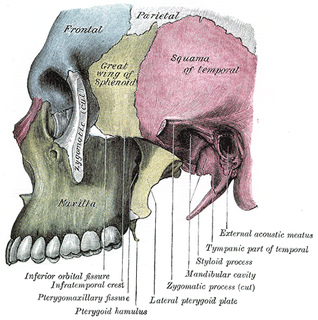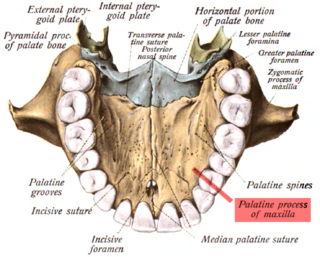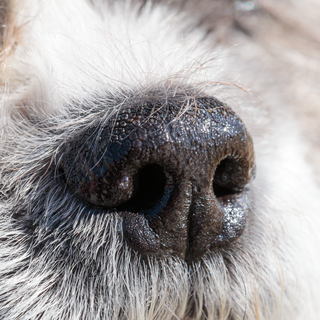
The skull is a bone structure that forms the head in vertebrates. It supports the structures of the face and provides a protective cavity for the brain. The skull is composed of two parts: the cranium and the mandible. In humans, these two parts are the neurocranium and the viscerocranium that includes the mandible as its largest bone. The skull forms the anterior-most portion of the skeleton and is a product of cephalisation—housing the brain, and several sensory structures such as the eyes, ears, nose, and mouth. In humans these sensory structures are part of the facial skeleton.

The maxilla in vertebrates is the upper fixed bone of the jaw formed from the fusion of two maxillary bones. In humans, the upper jaw includes the hard palate in the front of the mouth. The two maxillary bones are fused at the intermaxillary suture, forming the anterior nasal spine. This is similar to the mandible, which is also a fusion of two mandibular bones at the mandibular symphysis. The mandible is the movable part of the jaw.

The jaw is any opposable articulated structure at the entrance of the mouth, typically used for grasping and manipulating food. The term jaws is also broadly applied to the whole of the structures constituting the vault of the mouth and serving to open and close it and is part of the body plan of humans and most animals.

The frontal bone is a bone in the human skull. The bone consists of two portions. These are the vertically oriented squamous part, and the horizontally oriented orbital part, making up the bony part of the forehead, part of the bony orbital cavity holding the eye, and part of the bony part of the nose respectively. The name comes from the Latin word frons.

Galesaurus is an extinct genus of carnivorous cynodont therapsid that lived between the Induan and the Olenekian stages of the Early Triassic in what is now South Africa. It was incorrectly classified as a dinosaur by Sir Richard Owen in 1859.

Jeholosaurus is a genus of neornithischian dinosaur from the Early Cretaceous Period. It is thought to have been a herbivorous small ornithopod.

In human anatomy of the mouth, the palatine process of maxilla, is a thick, horizontal process of the maxilla. It forms the anterior three quarters of the hard palate, the horizontal plate of the palatine bone making up the rest.

Paludirex is an extinct genus of mekosuchine crocodylians from the Pliocene and Pleistocene of Australia. Remains of this animal have been found in the Riversleigh lagerstätte of northwestern Queensland. It was a medium-sized crocodile, estimated to grow to at least 4 metres in length.

Chimaerasuchus is an extinct genus of Chinese crocodyliform from the Early Cretaceous Wulong Formation. The four teeth in the very tip of its short snout gave it a "bucktoothed" appearance. Due its multicusped teeth and marked heterodonty, it is believed to have been an herbivore. Chimaerasuchus was originally discovered in the 1960s but not identified as a crocodyliform until 1995, instead thought to possibly be a multituberculate mammal. It is highly unusual, as only two other crocodyliforms have displayed any characteristics resembling its adaptations to herbivory.

A nose is a protuberance in vertebrates that houses the nostrils, or nares, which receive and expel air for respiration alongside the mouth. Behind the nose are the olfactory mucosa and the sinuses. Behind the nasal cavity, air next passes through the pharynx, shared with the digestive system, and then into the rest of the respiratory system. In humans, the nose is located centrally on the face and serves as an alternative respiratory passage especially during suckling for infants. The protruding nose that completely separate from the mouth part is a characteristic found only in therian mammals. It has been theorized that this unique mammalian nose evolved from the anterior part of the upper jaw of the reptilian-like ancestors (synapsids).

The evolution of mammalian auditory ossicles was an evolutionary event that resulted in the formation of the bones of the mammalian middle ear. These bones, or ossicles, are a defining characteristic of all mammals. The event is well-documented and important as a demonstration of transitional forms and exaptation, the re-purposing of existing structures during evolution.

The premaxilla is one of a pair of small cranial bones at the very tip of the upper jaw of many animals, usually, but not always, bearing teeth. In humans, they are fused with the maxilla. The "premaxilla" of therian mammal has been usually termed as the incisive bone. Other terms used for this structure include premaxillary bone or os premaxillare, and intermaxillary bone or os intermaxillare.

Chenoprosopus is a genus of extinct cochleosauridae that lived during late Carboniferous and early Permian periods. Two known species of Chenoprosopus are C. milleri and C. lewisi. Chenoprosopus lewisi was described in the basis of a virtually complete skull with maximum skull length of 95 mm. It is significantly smaller than Chenoprosopus milleri and was differentiated from that taxon by Hook (1993) based on sutural patterns of the skull roof. Hook also mentioned the reduced size of the vomerine tusks differentiated C. lewisi from C. milleri, but the different size of these tusks may be different ontogenetic stages of growth. Many of other cochleosaurids from the same time period have an elongated vomer and wide and elongate choana. However, Chenoprosopus is distinguished by its more narrowly pointed snout and separation between the nasal from the maxilla by the broad lacrimal-septomaxilla contact.

Mesenosaurus is an extinct genus of amniote. It belongs to the family Varanopidae. This genus includes two species: the type species Mesenosaurus romeri from the middle Permian Mezen River Basin of northern Russia, and Mesenosaurus efremovi from the early Permian (Artinskian) Richards Spur locality. M. romeri’s stratigraphic range is the middle to late Guadalupian while M. efremovi’s stratigraphic range is the Cisuralian.
Pravusuchus is an extinct genus of leptosuchomorph phytosaurid phytosaur known from the Late Triassic of Arizona, United States. It contains a single species, Pravusuchus hortus, which is known from three specimens. These specimens were previously referred to Smilosuchus or to Leptosuchus, but Pravusuchus's autapomorphy, its phylogenetic position as well as a trait shared with pseudopalatines, justified the erection of a new taxon for the material.
Ovoo gurvel is an extinct monitor lizard from the Late Cretaceous of Mongolia. It is one of the smallest and earliest monitor lizards. It was described in 2008. Ovoo possesses a pair of two small bones in its skull that are not seen in any other lizard.
Aiolosaurus is an extinct genus of monitor lizard from the Late Cretaceous of Mongolia. The type and only species, Aiolosaurus oriens, was named in 2000 from Ukhaa Tolgod, a rich fossil site in the Campanian-age Djadochta Formation.

An interparietal bone is a dermal bone situated between the parietal and supraoccipital. It is homologous to the postparietal bones of other animals.

Mosaiceratops is a genus of ceratopsian, described by Zheng, Jin & Xu in 2015 and found in the Xiaguan Formation of Neixiang County. Mosaiceratops lived in the upper Cretaceous in what is now the Henan Province of China.

Kyhytysuka is an extinct genus of ophthalmosaurian ichthyosaur from Early Cretaceous Colombia. The animal was previously assigned to the genus Platypterygius, but given its own genus in 2021. Kyhytysuka was a mid-sized ophthalmosaurian with heterodont dentition and several adaptations suggesting that it was a macropredatory vertebrate hunter living in shallow waters. It contains a single species, Kyhytysuka sachicarum.


















